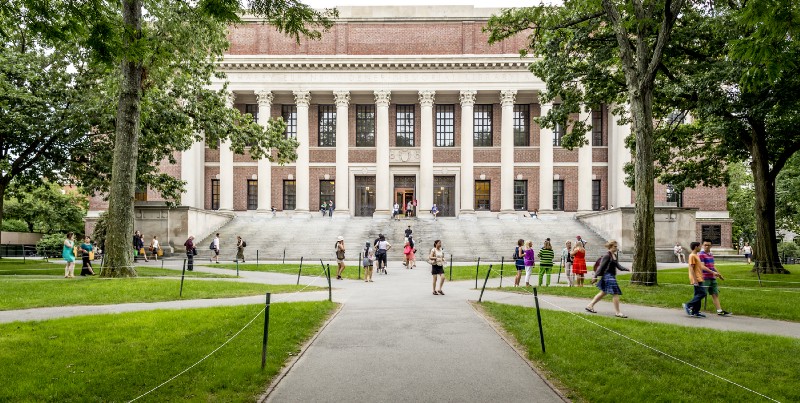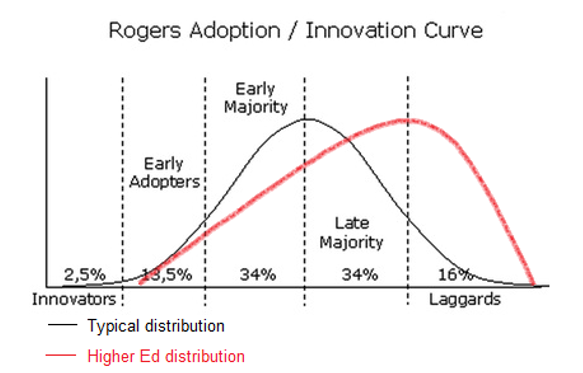WAITING FOR OUR PROBLEMS TO SUBSIDE IS NOT THE ANSWER

Financial sustainability and student success were common themes in higher education news this week. Chancellors, presidents, and provosts highlighted student success initiatives and controlling costs as their top two priorities. S&P announced declining credit ratings. Provosts/chief academic officers, in another survey, overwhelmingly agreed that new programs will need to come from reallocation of existing resources.
Pervasive focus on these critical topics in our industry is good news. My concern is that pervasive focus doesn’t always lead to pervasive momentum. In fact, many institutions suffer from a reluctance to take decisive action even in the face of compelling need for action. Why might this be, and what can we do to initiate more decisive action and the resulting progress needed in these areas?
The classic theory of innovation, Diffusion of Innovations, sheds some light on these questions. This theory was popularized by Everett Rogers in his book Diffusion of Innovations, which was first published in 1962, and is now in its fifth edition. The theory seeks to explain how, why, and at what rate new ideas and technology spread. Rogers emphasizes the context, especially the participants in any “social system,” are the key to adoption, progress, and the goal of reaching the ultimate end-state of self-sustaining innovation. Diffusion is the process by which an innovation is communicated over time among the participants in a social system.
The categories of adopters are innovators, early adopters, early majority, late majority, and laggards. Diffusion, or the spread of the innovation, happens very differently within these categories. Based on my own career experience — working with higher education institutions since 1987 — I’d argue that higher education’s adoption of innovation lags that of most industries (see my estimate below with the red line).

Regardless, we can all agree that creating more progress on financial sustainability and student success requires a strong commitment to innovation. That commitment must take the form of more institutions aggressively tackling these complex issues. We need early adopters to, in some situations, be innovators (and so on). We need more than the relatively small group of institutions that dominate the headlines stepping out of their comfort zone and innovating more and earlier. Mostly, we need more institutions and their students benefiting from the measurable wins in sustainability and student outcomes enjoyed by too few today.
Admittedly, this is a heavy lift. Sticking our toe in the innovation pool will not suffice. We know this from the overwhelming evidence that strategies to lift siloed innovations in these areas have had little impact. The institutions that are moving the needle on these fronts are taking comprehensive, integrated approaches. We need synthesized innovation at scale.
Are progress in sustainability and student outcomes mutually exclusive? Not necessarily. While some student success initiatives are expensive, some advance sustainability. Either way, it’s clear that we need to get a lot better — as an industry — at being good stewards of our finances and our students.
The alternative to accelerated innovation is waiting and watching the challenges grow and become more complex. It’s hard to imagine financial support for higher education rebounding strongly in the next few years. National demographics point to fewer students to recruit and pay tuition. Our students and their needs are becoming more varied, making student success more nuanced each year. External stakeholders are more demanding and increasingly skeptical of the industry’s value proposition. Waiting is not the answer.
Ad Astra’s very targeted piece of the innovation puzzle is scheduling. We have learned that a student-aligned schedule can help an institution’s finances and students. The opportunities to control costs while accelerating tuition revenue and students’ velocity to completion are compelling. Decision support data that can lead to better schedules is aggressively leveraged on a relatively small — but growing — number of campuses.
Scheduling is only part of the equation. Administrative costs should continue to be a focus. The student success ecosystem includes pathways, student planners, advising and registration systems in the “progress” subset of the ecosystem that scheduling also inhabits. We also need to continue to advance innovation in the other areas of the ecosystem — access and engagement (the areas that proceed “progress”) and placement into a quality job (which follows “progress”).
Innovation is uncomfortable and messy. It’s also essential to the kind of progress higher education needs in these and other priority areas.



